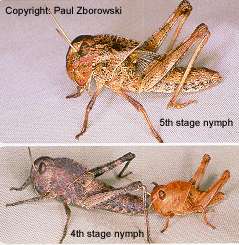Nymph description 7 of 15

Distribution

Nymph Description: In profile the thorax is domed well above the head in a well defined semi circle with a sharp crest. Dark stripes run from the antennae, along the eyes and across the thorax at a 45 degree angle, meeting at the top of the thorax (i.e. V shaped from above). Hind femur banded, as seen from above, but less distinct when viewed from the side. Rear tibia dark. The second wing bud has a dark spot along the top. This species is an infrequent pest of pasture and crops. When population densities are high, bands can form.
Confusion with Australian plague locust: None, as the domed thorax and larger size makes it very different.
Confusion with migratory locust: Similar size and domed appearance but lacks the hairy 'chest' (underside of thorax) of Locusta (compare photos).Unique features: The pronounced crested dome immediately distinguishes it from plague locust nymphs. Other species with an eye stripe can be confused here (especially Locusta and Oedaleus). However, the combination of a large domed thorax, banded rear femur and spotted second wing bud is unique together with a hairless 'chest'.
Phases: When gregarious, the dome on the thorax can flatten out and the colour may darken from the normal green-light brown to deep brown. Their shape is similar to gregarious Locusta nymphs but Locusta differs by the thorax becoming almost saddle-shaped and changing to bold black and orange.
Further information on this species: Description of adult
